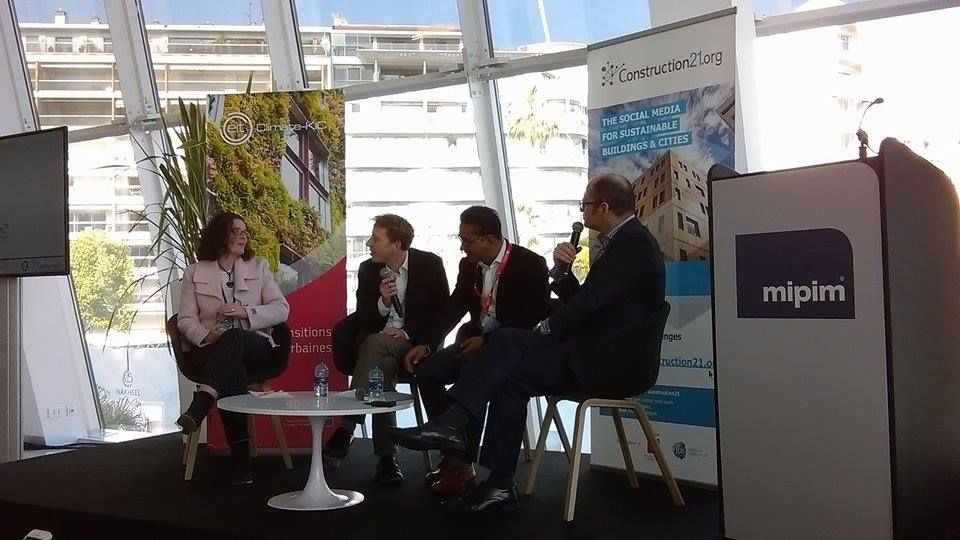The Eiffage Carbon fund, an ingenious tool to reduce greenhouse gas emissions
Construction21 Communication

Head of sustainable engineering at Eiffage, Joachim Lémeri was present at MIPIM during the conference "Cities against climate change: what actionable solutions?" co-organised by Construction21 and Green Planet Architects. In his speech, he talked about the Carbon Fund created by Eiffage. He answered our questions about this particularly innovative tool.
1. What is the Carbon Fund and how does it renew your approach to markets?
The Carbon Fund is a selective corporate fund to finance cost differentials between innovative low carbon solutions and traditional solutions. The tool was created by Eiffage Group in 2010 and experimented during the construction of the high speed train line between Le Mans and Rennes (2012-2015). It represents a leverage in reducing the carbon footprint of an operation: it removes the financial lock sometimes caused by low carbon solutions (technics, materials…). Eiffage’s Carbon-Energy Corporate Fund (E-FACE) is a voluntary approach and internally self-financed and now it is general within the whole Group since the beginning of 2017. As innovative tool, it aims to encourage the search for solutions emitting less GHG or energy efficient, in a sector not submitted to the carbon market and which industrial logics don’t generally allow the questioning of standards and practices. Lastly, it sets up the « carbon » variable as a complementary key-parameter in the analysis and the comparison of technics and technologies, along other usual criteria.
2. With a subject so transversal and an operation of that magnitude, how could you involve all stakeholders?
Each actor of the operation, engineer, ecologist, QSE, project manager, supervisor, technical manager, or innovation manager, or even the buyer,… All of them can submit a low carbon solution by applying on an internal platform accessible to all. The solution, by highlighting avoided carbon emissions and the cost generated to avoid them, is submitted to an analysis by an internal validation committee. When the cost of the avoided ton of CO2 is low enough, the solution is funded right away. This is a great way for every operational and functional responsibility to develop innovation and favour feedbacks that could inspire new solutions for other operations or even other activities of the company. The standard cost of avoided ton of CO2 allows easier comparisons and emulation between teams.
 3. What are the early feedbacks of this first Carbon Fund ? Is it replicable and on what scale?
3. What are the early feedbacks of this first Carbon Fund ? Is it replicable and on what scale?
During the realisation of the high speed train line Le Mans Rennes, from 2012 to 2015, 54 requests for funding through the Carbon Fund have been recorded, and 22 solutions have been validated. During the construction, 14,000 tons of CO2 have been avoided thanks to this fund, the equivalent of the emissions caused by the construction of 2km of high-speed train line, or the annual emissions of the famous Paris-Dakar rallye. Implementing the Carbon Fund in this vast and multiprofessional project provided us with a meaningful feedback addressed in May 2016 in a focus article of the « Carbon Footprint of Railway Infrastructure » published by the UIC (International Union of Railways). The fund was also presented during the UIC Congress in Wien, in October 2016. This Congress was dedicated to sustainable development issues.
By generalising the fund tested on this railway project, within the whole Eiffage Group in 2017, other operations will benefit from this leverage.
4. Can we imagine this fund to be applied to construction of buildings or districts?
This is even our goal with this fund. It can be applied to all branches of the Eiffage Group, including real estate and urban planning. The fund aims to bring about alternatives, technical and organisational innovations, and - why not? To question construction practices and usual standards to see the difference. It can also be coupled to other tools often used in the real estate sector, like energy efficiency certificates (EEC).



